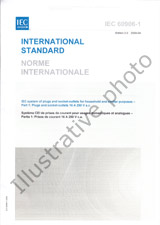We need your consent to use the individual data so that you can see information about your interests, among other things. Click "OK" to give your consent.

IEC 60068-3-8-ed.1.0
Environmental testing - Part 3-8: Supporting documentation and guidance - Selecting amongst vibration tests
STANDARD published on 28.8.2003
The information about the standard:
Designation standards: IEC 60068-3-8-ed.1.0
Publication date standards: 28.8.2003
SKU: NS-408693
The number of pages: 45
Approximate weight : 135 g (0.30 lbs)
Country: International technical standard
Category: Technical standards IEC
The category - similar standards:
Annotation of standard text IEC 60068-3-8-ed.1.0 :
Provides guidance for selecting amongst the IEC 60068-2 stationary vibration test methods Fc sinusoidal, Fh random and F(x) Mixed mode vibration. The different steady-state test methods and their aims are briefly described in Clause 4. Transient test methods are not included. For vibration testing, the environmental conditions, especially the dynamic conditions for the specimen, should be known. This standard helps to collect information about the environmental conditions (Clause 5), to estimate or measure the dynamic conditions (Clause 6) and gives examples to enable decisions to be made on the most applicable environmental vibration test method. Starting from the condition, the method of selecting the appropriate test is given. Since real life vibration conditions are dominated by vibration of a random nature, random testing should be the commonly used method, see Table 1, Clause 7. The methods included hereafter may be used to examine the vibration response of a specimen under test before, during and after vibration testing. The selection for the appropriate excitation method is described in Clause 8 and tabulated in Table 2. In this standard specification, writers will find information concerning vibration test methods and guidance for their selection. For guidance on test parameters, or severities of one of the test methods, reference should be made to the normative references. Fournit les lignes directrices pour la selection parmi les methodes dessais Fc de vibrations stationnaires sinusoidales, Fh aleatoires et Fx composites de la serie 60068-2. Ces differentes methodes dessais quasi stationnaires ainsi que leur objet sont brievement decrites a lArticle 4. Les methodes dessais en transitoire ne sont pas incluses. Lors de la realisation dessais en vibration, il convient de connaitre les conditions denvironnement, et specialement les conditions dynamiques du specimen en essai. La presente norme aide a reunir linformation relative aux conditions denvironnement (Article 5), a estimer ou a mesurer les conditions dynamiques (Article 6) et donne des exemples afin dillustrer les choix a realiser pour la plupart des methodes dessais applicables en environnement vibratoire. A partir des conditions denvironnement, la methodologie de choix de lessai approprie est fournie. Puisque les conditions denvironnement vibratoire naturelles sont de nature aleatoire, il est recommande que les essais en vibrations aleatoires soient generalement, les methodes retenues (voir Tableau 1, Article 7). Les methodes decrites ci-apres peuvent etre utilisees pour examiner la reponse vibratoire du specimen en essai avant, pendant et apres un essai de vibrations. Le choix de la methode appropriee est decrit a lArticle 8 et presente au Tableau 2. Les specificateurs trouveront dans la presente norme les informations relatives aux methodes dessais vibratoires et les lignes directrices pour choisir parmi elles la methode appropriee. Pour choisir les parametres ou les severites relatives a lune de ces methodes, il y a lieu de se reporter aux references normatives.
We recommend:
Technical standards updating
Do you want to make sure you use only the valid technical standards?
We can offer you a solution which will provide you a monthly overview concerning the updating of standards which you use.
Would you like to know more? Look at this page.



 Cookies
Cookies
